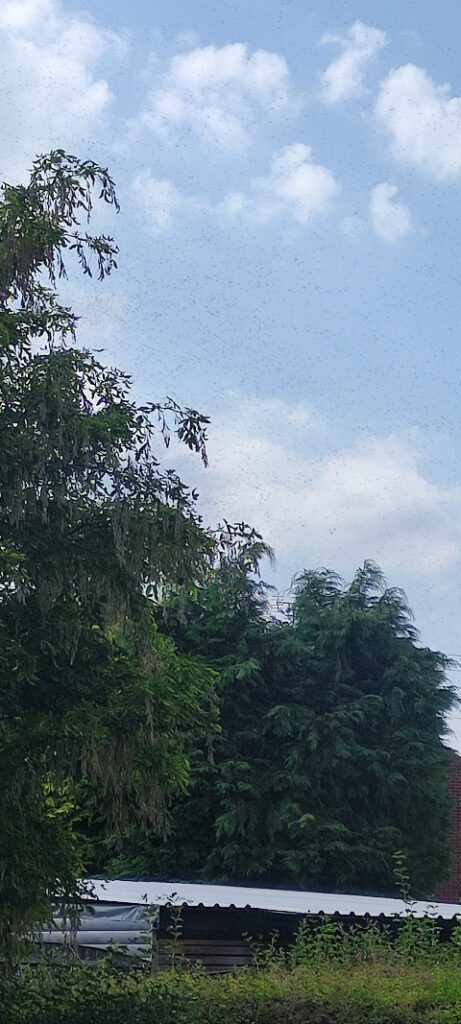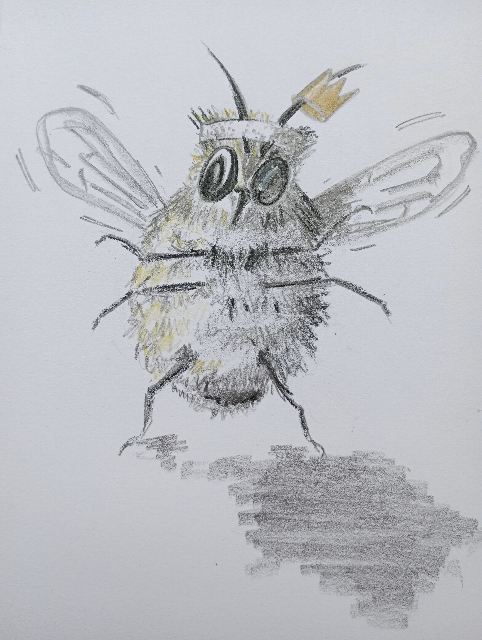
The Birds Bees
It was a quiet afternoon in a leafy suberb of Sheffield. The towels were drying nicely on the line; hubby had brought out his work, having been driven from the loft in the soaring temperatures.
Suddenly, I heard a very loud buzzing. You know, like the stuff of horror movies (if I watched them).
“Get inside, now!” I shouted to my husband as I abandoned the washing and herded the dogs inside (just the two—‘herded’ may be a little elaborate).
After a few mad seconds of securing all the windows, we looked outside to see a huge swarm. Even people on the street were stopped in their tracks by the noise and black cloud that was circling above.
At the time we had no idea whether we were dealing with bees or wasps. And having already experienced a few pretty nasty run-ins with accidentally-disturbed wasp nests at the woods, I wasn’t taking any risks.
From the safety of the house, it was a truly fascinating site. My son got his camera and hubby managed to get a photo: honey bees. Well, that was a relief. And really good to see with all that you hear about the declining bee population. I appreciate that wasps also play a really important role in the ecosystem but appreciate a little more distance between me and them.

Over the next half an hour, the cloud became more concentrated around a small tree in the neighbour’s garden, until eventually there were just a few hovering around the branch.
At that point, I decided that it was safe to venture out again to rescue the washing and the ancient guinea pig (who we deemed to be a little risk, being close to the ground).
Beecause…
But this whole episode got me thinking (and Googling). Why do bees swarm?
There are a couple possiblilities. The weather was very warm (for Yorkshire), up at around 26 degrees celcius. Bees may swarm simply if their hive gets too hot and humid. Other factors such as lack of food or water, or even the presence of a parasite can also result in absconding.
However, as a warm sunny day at the end of July, following a rather unsettled period of weather, probably the most likely candidate was the result of a healthy bee colony reproducing.
Battle royal
As I understood it, a bee colony is centred around a queen. So how does this work? Does the colony just up and move to bigger premises when the hive gets too crowded? Well, no. It’s a bit more complicated than that.
Swarming that’s planned, and not due to environmental conditions, is a military operation. I don’t use the word ‘planned’ lightly here. Swarming takes weeks of preparation.
The workers start to get the queen ready for her flight. To put it bluntly, she’s put on a few pounds being stuck in the hive for the majority of her life and is a bit out of shape. So, they put her on a diet and give her a boot camp-style workout.

At the same time, workers feed up some of the specially-chosen fertlised eggs. They basically give them an overdose of royal jelly that allows their reproductive organs to fully develop (unlike the female workers who can only lay unfertlised eggs that develop into drones—the males whose only job is to mate with the queen and then die. Great.).
Now, if you’re feeling sorry for our starving and exhausted old queen, read on. Our new queens start to hatch and call to each other. No, they’re not being friendly. They’re calling in their competition for a fight to the death. There’s only one new queen allowed on this block.
So what about the old queen? Well, this is where we get back to the swarming. Old queeny is now in good enough shape to make it out of the hive and is accompanied by around half of the existing colony. The other half stay put with their new queen, where they can grow and prosper.
However, old queeny gets tired rather quickly and the swarm will need to find a somewhere to rest for a few hours or days while workers go scouting for their new permanent residence.
Official residence?
This morning, as I gaze out of the window at my neighbour’s tree, I can still see a few honey bees hovering around the branch. There are certainly quite a few bees in the garden, too, so my raspberries should do well this year.
From what I’ve read, I doubt that this tree will be their final home. Honey bees build their nests in cavities, either above or below ground. Next door’s tree is pretty small and healthy, so I doubt that there are any hollows that would be suitable for them there.
Only time will tell. In the meantime, this has been a great opportunity to find out more about these amazing (and quite frankly, rather brutal) pollinators.
